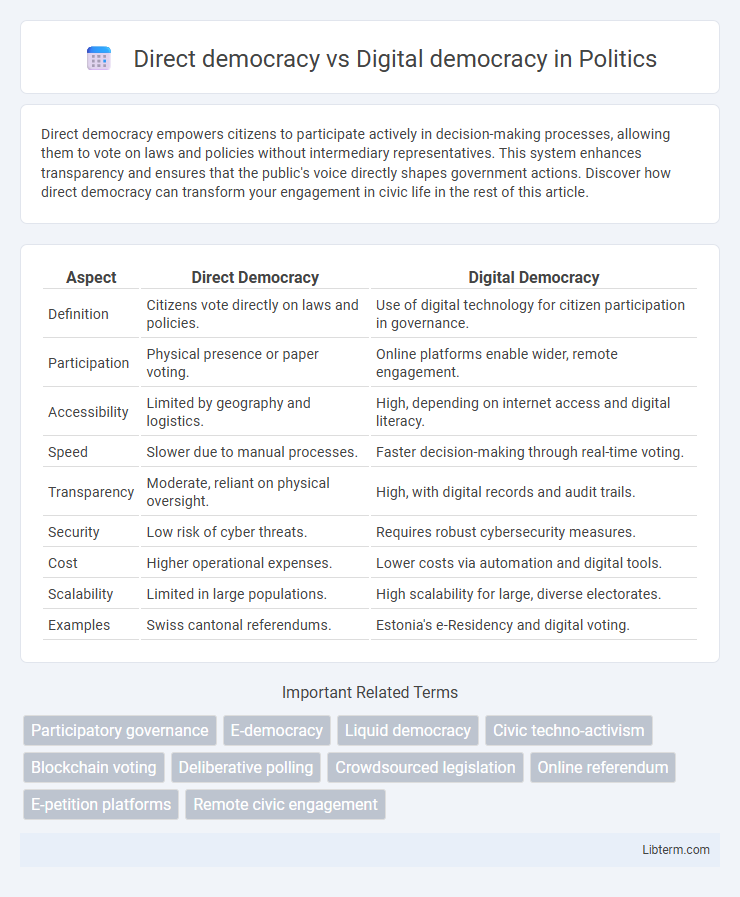Direct democracy empowers citizens to participate actively in decision-making processes, allowing them to vote on laws and policies without intermediary representatives. This system enhances transparency and ensures that the public's voice directly shapes government actions. Discover how direct democracy can transform your engagement in civic life in the rest of this article.
Table of Comparison
| Aspect | Direct Democracy | Digital Democracy |
|---|---|---|
| Definition | Citizens vote directly on laws and policies. | Use of digital technology for citizen participation in governance. |
| Participation | Physical presence or paper voting. | Online platforms enable wider, remote engagement. |
| Accessibility | Limited by geography and logistics. | High, depending on internet access and digital literacy. |
| Speed | Slower due to manual processes. | Faster decision-making through real-time voting. |
| Transparency | Moderate, reliant on physical oversight. | High, with digital records and audit trails. |
| Security | Low risk of cyber threats. | Requires robust cybersecurity measures. |
| Cost | Higher operational expenses. | Lower costs via automation and digital tools. |
| Scalability | Limited in large populations. | High scalability for large, diverse electorates. |
| Examples | Swiss cantonal referendums. | Estonia's e-Residency and digital voting. |
Introduction to Direct Democracy and Digital Democracy
Direct democracy enables citizens to vote directly on laws and policies, ensuring active participation without intermediary representatives. Digital democracy leverages technology and online platforms to facilitate broader, more accessible citizen engagement in decision-making processes. Both models aim to enhance democratic involvement but differ in mechanisms and scalability.
Historical Evolution of Direct Democracy
Direct democracy traces back to ancient Athens around 5th century BCE, where citizens directly participated in political decision-making through assemblies. This system evolved slowly over centuries, influencing some cantons in Switzerland and New England town meetings as modern examples. Digital democracy builds upon this foundation by leveraging internet technologies to enable broader, real-time citizen participation in governance, transforming traditional direct democracy into a more scalable and accessible model.
Emergence and Growth of Digital Democracy
The emergence of digital democracy stems from advances in information technology and widespread internet access that facilitate real-time public participation and decision-making beyond traditional direct democracy methods. Digital platforms enable greater inclusivity, transparency, and interaction by integrating social media, online voting, and e-petitions to engage citizens at scale. Growth in digital democracy continues as governments and organizations invest in secure digital infrastructure and blockchain technologies to enhance trust and reduce barriers to civic engagement.
Key Principles: Direct vs Digital Approaches
Direct democracy emphasizes citizens' direct participation in decision-making through methods like referendums and initiatives, ensuring unmediated public influence on policy. Digital democracy incorporates online platforms and digital tools to facilitate broader engagement, transparency, and real-time interaction, enhancing accessibility and inclusivity in political processes. Both models prioritize citizen involvement but differ in execution: direct democracy relies on physical or formal voting mechanisms, while digital democracy integrates technology to streamline and expand participation.
Tools and Technologies of Digital Democracy
Digital democracy leverages advanced tools such as blockchain for secure voting, online platforms for real-time public consultations, and AI-powered analytics to gauge citizen sentiment, vastly enhancing participation compared to traditional direct democracy methods. These technologies enable scalable, transparent, and efficient decision-making processes by facilitating instant feedback loops and ensuring integrity through tamper-proof ledgers. Unlike direct democracy's reliance on physical assemblies or paper ballots, digital democracy integrates mobile apps, social media, and cloud computing to broaden inclusivity and accessibility in governance.
Citizen Participation: Analog vs Digital
Citizen participation in direct democracy relies on in-person assemblies and paper ballots, emphasizing face-to-face deliberation and physical presence. Digital democracy transforms engagement through online platforms, enabling real-time voting, discussion forums, and broader accessibility regardless of location. The shift from analog to digital methods increases inclusivity, lowers barriers to participation, and accelerates decision-making processes.
Benefits and Challenges of Direct Democracy
Direct democracy offers the benefit of increased citizen participation in decision-making, fostering a stronger sense of accountability and community involvement through mechanisms like referendums and initiatives. However, challenges include the risk of majority tyranny, complexity in managing large-scale participation, and the potential for misinformation to sway public opinion. These factors can limit the effectiveness and fairness of direct democracy compared to representative or digital democratic models.
Advantages and Limitations of Digital Democracy
Digital democracy enhances citizen participation by enabling real-time voting, widespread information access, and increased transparency through digital platforms. Security vulnerabilities and digital divides limit equal access and risk data breaches, while misinformation and lack of personal interaction challenge informed decision-making. Despite these issues, digital democracy streamlines public engagement and fosters inclusive governance by leveraging technology for efficient collective input.
Security, Privacy, and Trust Issues
Direct democracy often struggles with scalability and secure vote tallying, leading to concerns about vote manipulation and transparency. Digital democracy leverages encryption and blockchain technologies to enhance security and privacy, yet it faces challenges in preventing cyberattacks and ensuring user authentication. Building trust in both systems requires robust protocols, transparent auditing mechanisms, and continuous advancements in cybersecurity standards.
Future Outlook: Integrating Direct and Digital Democracy
The future outlook of democracy envisions integrating direct democracy's citizen-led decision-making with digital democracy's technological platforms to enhance participation efficiency and transparency. Emerging technologies like blockchain and AI are pivotal in ensuring secure voting systems and real-time public discourse, bridging offline and online engagement. This fusion aims to empower broader demographic involvement, reduce barriers to participation, and create more responsive governance models worldwide.
Direct democracy Infographic

 libterm.com
libterm.com